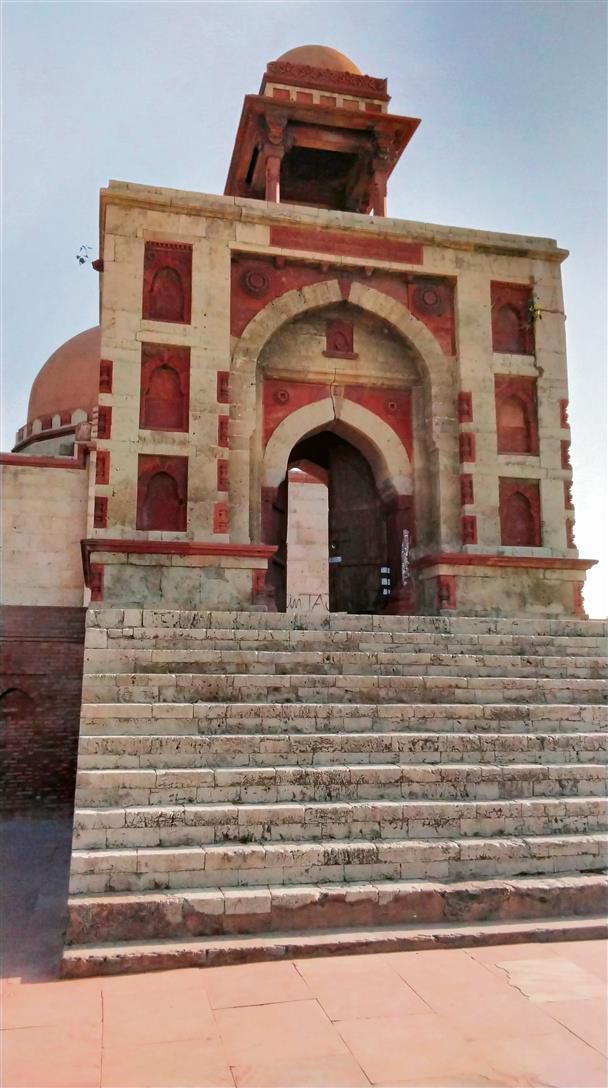Sonepat’s hidden treasure, the tomb of Khwaja Khizr
Alka Raza
The tomb of Khwaja Khizr at Sonepat in Haryana is not on the tourist map of Delhi-NCR. It comes up rarely in conversations of heritage enthusiasts. Yet, the historical landmark, built during 1522-1524 by Ibrahim Lodhi, has a lot of a significance attached to it. Considered the last monument of the Lodhi dynasty era, what also makes it special is the structural composition — built with kankar blocks, red sandstone and Lakhauri bricks.
Khwaja Khizr was revered as a Sufi saint. A spiritual leader of the Lodhi period, he had renounced court life in search of the ‘real meaning of life’. It was the time when the Sufi and Bhakti movements were at their peak. He was frequently consulted on matters of importance by nobles and royals of the time.
I first visited the tomb in January 2019 in a quest to locate the centuries-old trees by the pond in Jatwara, a historical locality in the city of Sonepat. The 500-year-old tomb is surrounded by lush green gardens, next to a pond and many ‘heritage trees’.
Reaching this 16th-century monument through the busy, narrow streets of Jatwara village is an experience. Completely hidden by the semi-urban structures, the road, which has all kinds of shops, ends suddenly, and the maqbara of Khwaja Khizr rises like a phoenix. A beautiful, picturesque heritage building greets you to take you back to an era gone by — the Lodhis of Delhi Sultanate!
According to the Archaeological Survey of India (ASI), not much is known about this tomb of Indo-Islamic architecture. Built in honour of Khwaja Khizr, it stands on a high platform and is reinforced with square projections at the corners. A flight of steps leads to the gateway, which consists of two arched openings on either side of a central passage decorated with panels, recessed arches, mouldings, lotus medallions and inscriptions.
A chhatri is located on the top of the gateway. The main structure is square in plan, with four openings on all sides, except the western wall where a mihrab is located. The ceiling of the chamber is decorated with floral designs executed in blue, yellow, green and dull red colours. The burial chamber is surmounted by a hemispherical dome, resting on an octagonal low drum, crowned by a final sitting over an inverted lotus flower.
According to the Persian inscriptions on the tomb, Khwaja Khizr was the son of Darya Khan Sarwani, an influential noble in the court of Sikandar Lodhi.
For many decades, the residents of Jatwara and nearby areas have been taking care of this lesser-known heritage of Haryana. They never fail to offer flowers, food and light incense and oil lamps every Thursday and Friday, and pay their respect to the pir.
“No one goes empty-handed from here,” say Angooree and Shanti, narrating to me the people’s belief and some magical stories, insisting that I too make a wish and tie a thread. At 45ºC, I could not concentrate on any ‘mannat’ and thought that perhaps Khwaja Khizr wants me to come back and pay my regards in a more appropriate manner!
The Bhakti and Sufi movements of medieval India played a crucial role in creating a composite culture, and the legacy can be seen to this day. The dargah is frequented by people of different faiths, travelling from far and near distances, like a family I met from Kashmir, especially to pray for good health. I was also greeted by local women during my recent visit to the Khwaja Khizr complex, which is becoming a social space to meet, exercise and do yoga. Needless to say, young cricketers were also making good use of the complex.
According to the ASI, a part of the boundary is being re-constructed, and hopefully then, this monument will be better taken care of. One wish I do have — that a heritage festival is organised on the lawns of the tomb so this site gets the recognition it deserves.
— The writer is ex-chairperson of XLRI Centre for Gender Equality and Inclusive leadership, Jamshedpur









